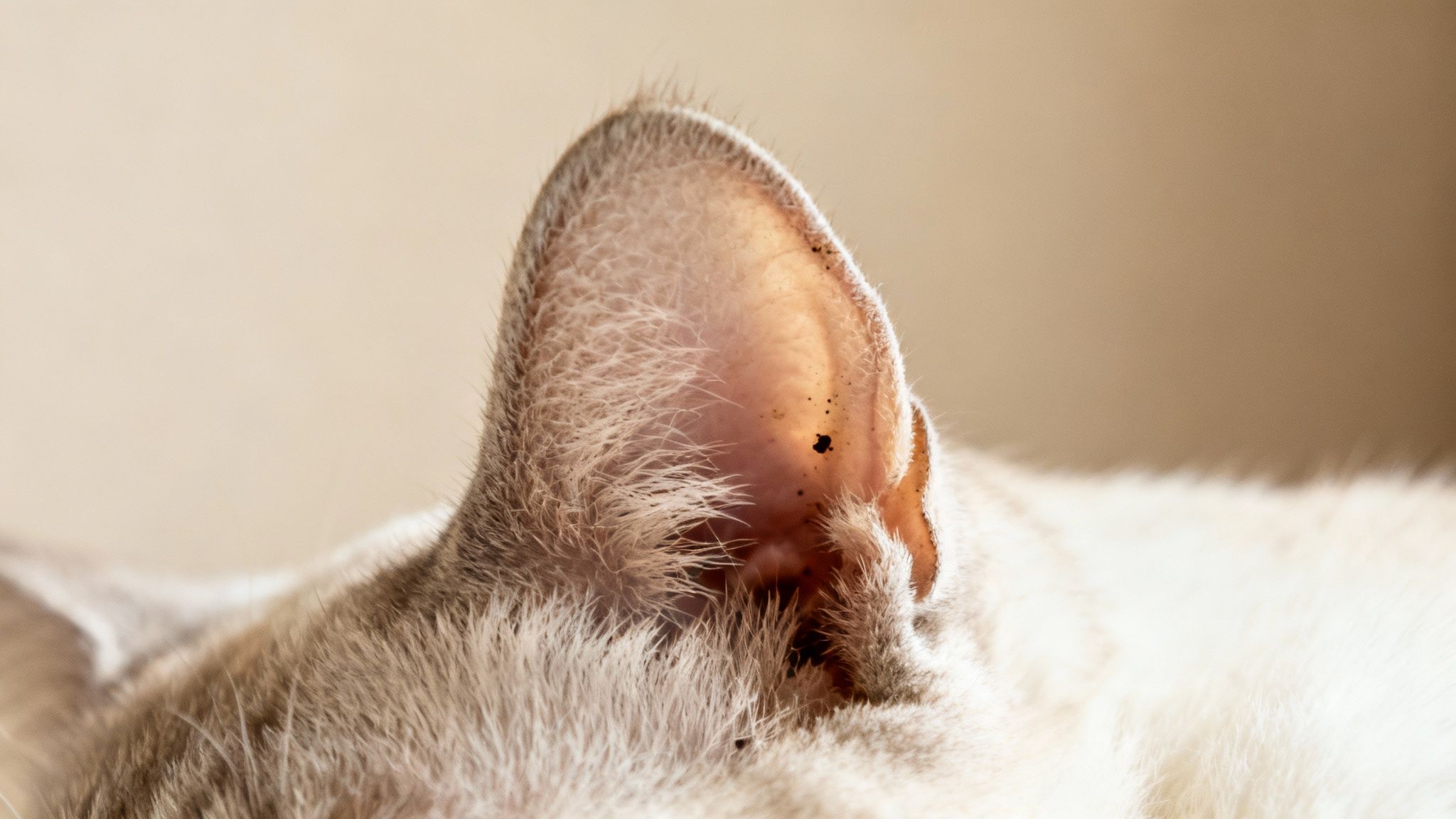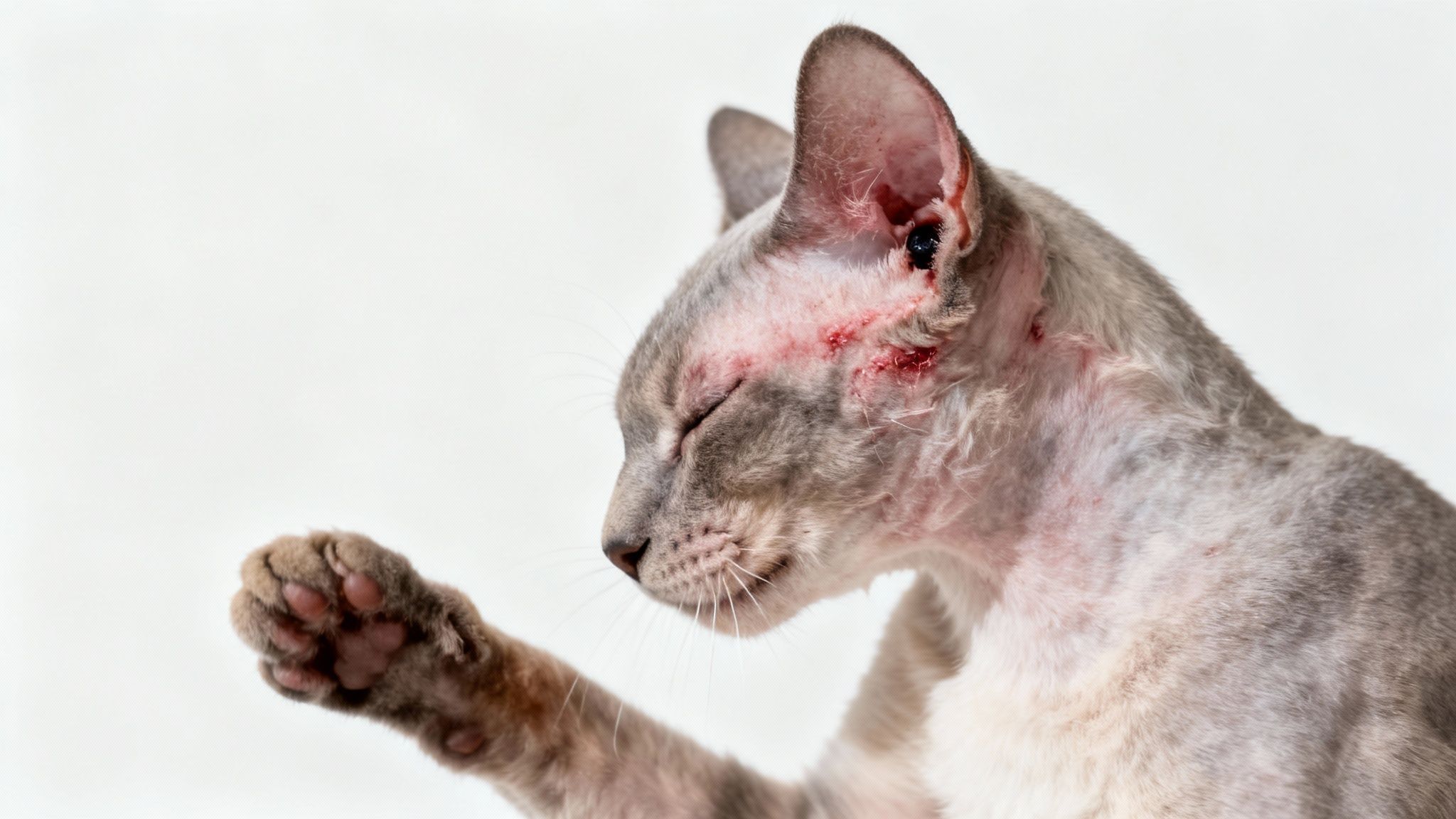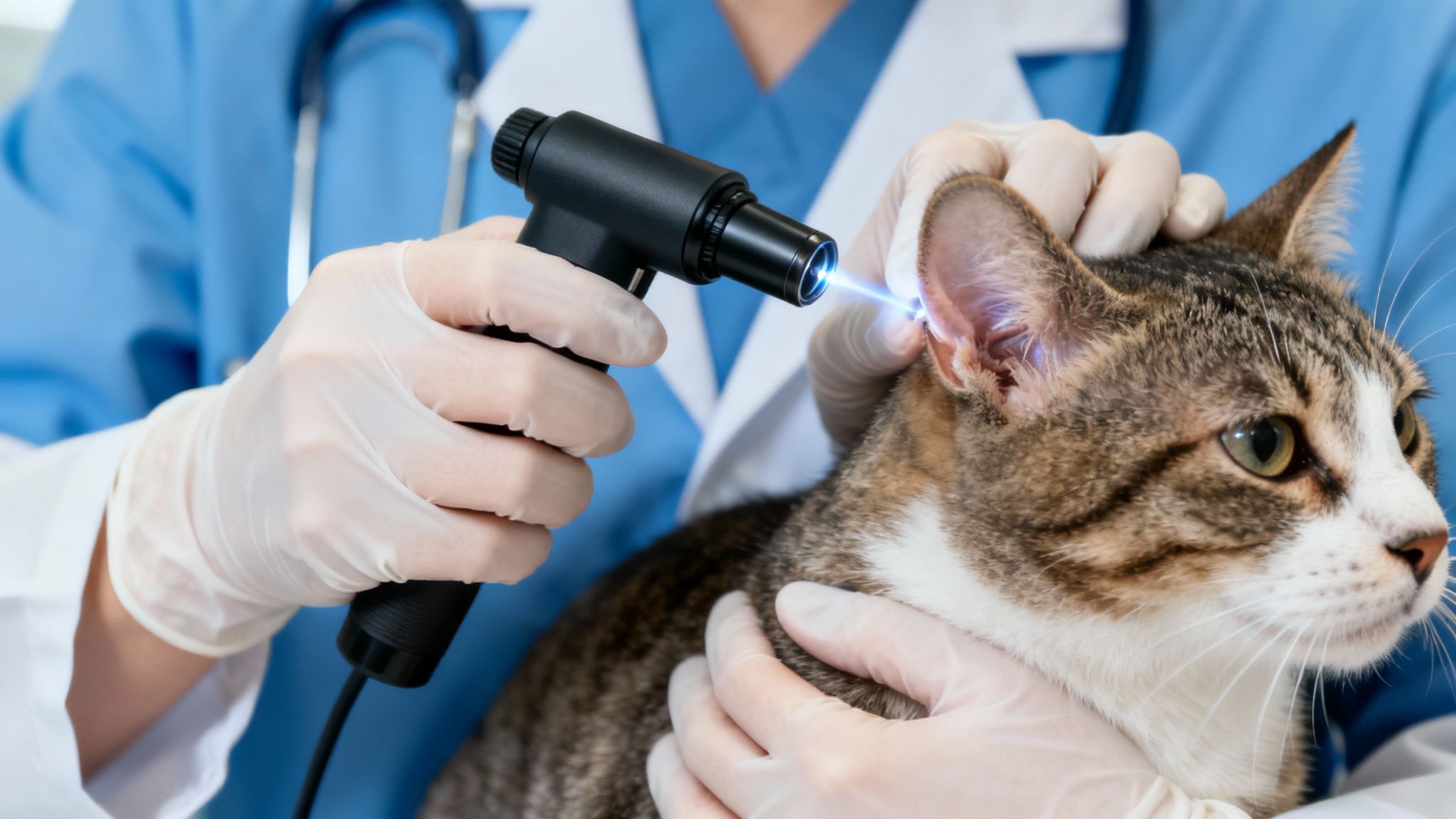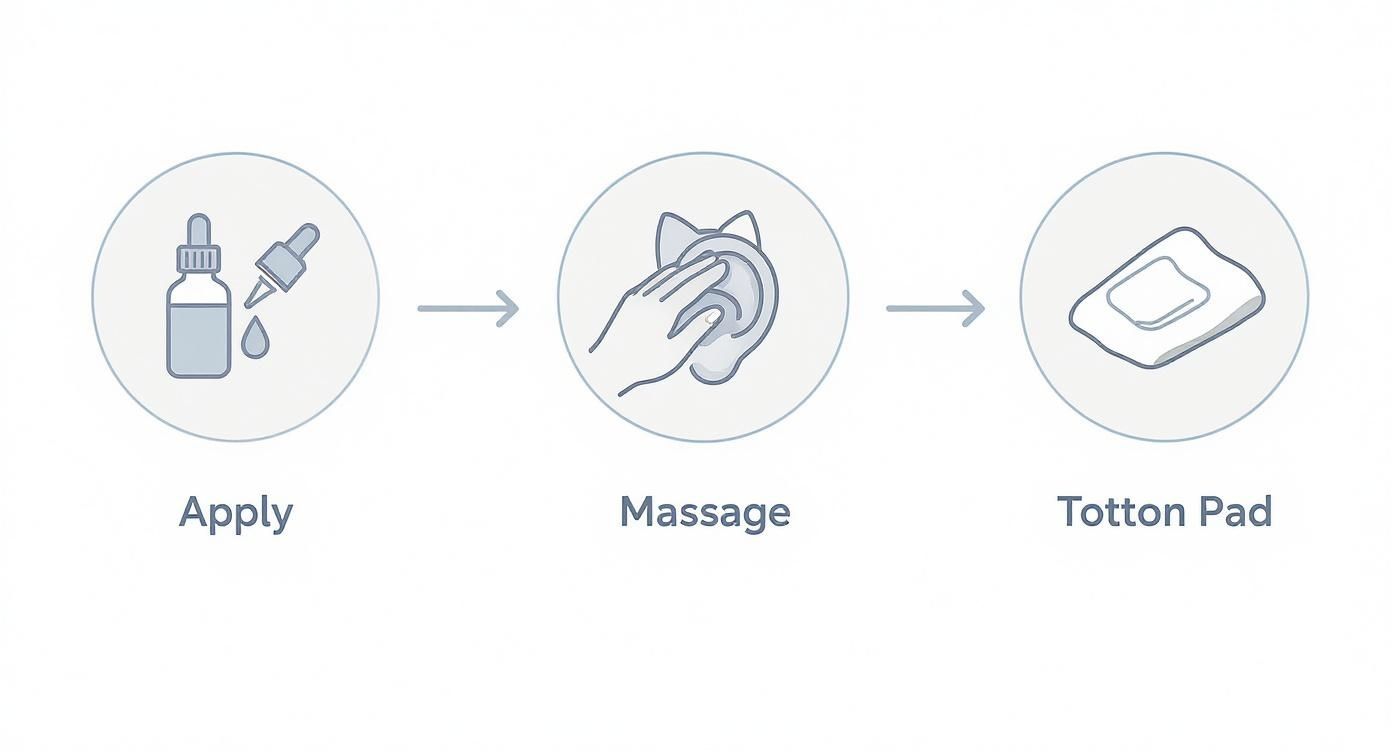If you've ever spotted dark, coffee ground-like gunk in your cat's ears, you're not alone. This is often the first, and most alarming, sign of a very common problem: ear mites. These microscopic critters, scientifically known as Otodectes cynotis, are a top cause of intense irritation and ear infections in our feline friends.
When you see your cat frantically scratching its ears or shaking its head nonstop, you're witnessing a desperate attempt to get some relief. The likely culprit is an infestation of ear mites, tiny eight-legged parasites that are far more common than many pet owners think. These pests aren't a reflection of poor hygiene or a dirty home; they are highly contagious and pass easily from one animal to another.

Think of your cat's ear canal as a warm, sheltered apartment building. For an ear mite, it's the perfect place to move in. These microscopic arachnids thrive on the wax and oils inside the ear, living out their entire three-week life cycle without ever needing to leave. All this activity is exactly what causes such major irritation for your cat.
An ear mite's life is a simple one: feed and reproduce, all within the safe confines of the ear canal. An adult female lays eggs that hatch in about four days. These larvae grow into adults over the next few weeks, ready to start the whole cycle over again. This rapid reproduction means a minor issue can quickly escalate into a severe infestation.
The number one way these mites spread is through direct physical contact with an infected animal. This puts certain cats at a much higher risk:
Ear mites are more than just an annoyance; they're a genuine health concern. The relentless scratching they trigger can lead to painful sores, secondary bacterial or yeast infections, and in serious cases, even damage the ear canal or eardrum if left untreated.
Understanding the local risk helps put the problem into perspective. Here in the UAE, the prevalence of these parasites is significant. Studies have shown high infection rates, which tells us this is a common challenge for local pet owners. For instance, research in nearby urban centers found a 25.47% prevalence rate among owned cats—meaning roughly one in every four cats was infected.
Ear mites are a type of ectoparasite, which simply means they live on the outside of their host's body. To get a better handle on similar pests that might affect your pets, you might find our guide on ectoparasites and everything you should know about them helpful. Knowing your enemy is the first step toward getting the right treatment and making your cat comfortable and happy again.
Has your cat suddenly started shaking its head like crazy or scratching its ears with a vengeance? These aren't just quirky habits. More often than not, they are the first distress signals of an ear mite infestation.
Spotting the signs of ear mites in cats ears early is the key to getting your furry friend the quick relief they need and heading off more serious problems down the road.

While a few different things can cause ear trouble, an infestation with the mite Otodectes cynotis leaves a very specific set of clues. If you pay close attention, you'll have a much better idea if a trip to the vet is in order.
Try to imagine the feeling of thousands of tiny bugs moving around inside your ear canal. It’s no wonder the discomfort triggers some very distinct behaviours in cats.
These aren't random actions. They are direct, telling responses to the severe irritation caused by mites feeding and living inside the ear.
Beyond how your cat is acting, there are physical signs inside the ear that point straight to mites. These are the classic symptoms a vet will be looking for during an examination.
The most famous sign of ear mites is a dark, crumbly discharge that looks a lot like dried coffee grounds. This isn't just regular earwax. It’s a nasty mix of wax, dried blood, inflammatory gunk, and the mites themselves, along with their waste. This substance is the hallmark of an ear mite problem.
You might also pick up on a distinct, unpleasant smell coming from your cat's ears. This foul odour is often caused by all the mite debris and can get much worse if a secondary bacterial or yeast infection takes hold in the damaged, inflamed ear canal.
A serious complication to watch for is an aural haematoma. This happens when the violent head shaking ruptures tiny blood vessels in the ear flap (pinna), causing a painful, blood-filled swelling. It needs immediate veterinary attention.
It's easy to mistake the signs of ear mites for other common ear problems, like a standard bacterial infection or even allergies. While a vet's diagnosis is essential, there are subtle differences you can look for.
A quick comparison can help you start to piece the puzzle together before your appointment.
While this table is a useful guide, the only way to know for sure what's going on is with a professional diagnosis from your vet. Think of these signs as your cat's way of telling you something is seriously wrong. A visit to the clinic is the crucial next step to confirm the cause and get them on the right treatment plan.
If you suspect your cat has ear mites, a trip to the vet is the next crucial step. While your observations at home are a great starting point, only a professional can give you a definite diagnosis and create a safe, effective treatment plan. Knowing what to expect during the visit can help calm any nerves—for both you and your cat.

The diagnostic process is quite straightforward and is all about pinpointing the exact cause of your cat's discomfort. This accuracy is vital because the signs of ear mites in cats ears can easily be mistaken for other problems, like a bacterial or yeast infection. We need to be sure before we treat.
Your vet will start with a thorough physical exam, paying close attention to your cat's ears and the skin around them. They’ll be looking for those classic signs you've probably already noticed, like redness, inflammation, and that tell-tale dark, crumbly discharge.
To get a much better view, the vet will use an otoscope, a special tool that lights up and magnifies the inside of the ear canal. Sometimes, if the infestation is heavy, they can actually see the tiny, white mites moving around against the dark debris. This visual check gives us some very strong clues.
But to be absolutely certain, your vet will take a small sample of the ear gunk using a gentle cotton swab. This sample is then placed on a slide and examined under a microscope.
This microscopic analysis is the gold standard for diagnosis. It allows the vet to clearly see the mites, their eggs, and larvae, confirming an active infestation and ruling out any other potential causes of irritation.
Once Otodectes cynotis is confirmed as the culprit, the focus shifts right away to getting your cat feeling better.
Thankfully, the days of complicated, drawn-out treatments are long gone. Modern veterinary medicine offers several highly effective and easy-to-use options to get rid of ear mites completely. It's so important to only use medications prescribed by your vet, as over-the-counter products are often ineffective and can even be harmful.
Your vet will pick the best treatment based on your cat's specific situation, but the main options are:
These treatments work incredibly well. A regional study on cats with ear mites found that a spot-on treatment with selamectin was 96.7% effective at clearing the infestation without any side effects. You can learn more about the findings on treatment efficacy.
Trying to self-diagnose and treat ear mites in cats ears is a risky move. A professional veterinarian is essential for a few key reasons. They can accurately diagnose the problem, rule out more serious conditions, and prescribe the right medication at the correct dose for your cat's specific weight and health.
More importantly, they'll advise you on treating every other pet in the house—even those showing no symptoms—to prevent a frustrating cycle of reinfection. Following your vet’s instructions to the letter, including finishing the full course of treatment, is the only way to ensure every last mite and egg is gone for good.
Because skin and ear issues can be complex, understanding your options for specialised veterinary dermatology services can offer real peace of mind for any future concerns. Your vet is truly your best partner in getting your cat back to being comfortable and healthy.
While your vet’s treatment is the heavy hitter that will knock out the ear mite infestation, your support at home is just as critical. Following your vet’s instructions for supportive care and cleaning can make a huge difference in your cat’s comfort and speed up their recovery. Let’s walk through the do’s and don’ts of at-home ear care.
The point of cleaning isn’t to cure the infestation on its own—that’s what the medicine is for. Instead, you’re clearing out all the gunk and debris. Think of it like sweeping fallen leaves off a path before you treat the weeds; it ensures the medication can get right where it needs to go.
Cats are creatures of habit, and most aren’t thrilled about having their ears touched, especially when they’re sore. If you can create a calm, predictable routine, it’ll be a less stressful experience for both of you.
First, get all your supplies ready before you fetch your cat. There’s nothing worse than trying to hold onto a wriggly, unhappy cat while you scramble to find the cotton balls.
Here's what you’ll need:
Pick a quiet room where your cat feels safe and can’t easily bolt. Use a soft, reassuring voice throughout the process to keep the mood as relaxed as possible.
Getting the technique right is crucial to avoid hurting your cat. Your vet should give you a demonstration, but here’s a quick rundown. Just remember, you’re only cleaning the parts of the ear you can easily see.
Never, ever insert anything into your cat’s ear canal. This includes cotton buds (Q-tips). Poking around in there can easily push debris deeper, compact it against the eardrum, or even rupture the eardrum itself. This can cause extreme pain and permanent hearing damage.
To keep things on track and prevent the mites from coming back, consistency is key. Since these parasites are so contagious, you’ll need to treat all the pets in your home as your vet recommends, even if they aren't showing any signs of ear mites in cats ears. This is the only way to break the cycle of re-infestation.
Beyond the ears, keeping a clean home environment is a big plus for your cat's overall health. If you're looking for broader guidance on keeping your home spotless and safe, check out this guide on choosing safe cleaning products for pets. Your hard work at home, combined with the right veterinary treatment, is the one-two punch that will get you a happy, mite-free cat.
Once your cat has successfully recovered from an ear mite infestation, your focus naturally shifts. The new goal? Making absolutely sure those horrible little pests never come back for a return visit. Prevention isn't just a passive idea; it’s an active strategy to shield your cat from future misery and the serious health problems that can follow.
The single best defense you can give your cat is consistent, year-round parasite control. Think of it as a protective bubble for your pet. Modern veterinary medicine offers some fantastic broad-spectrum products that are both powerful and incredibly easy to use.
Usually, these come as monthly spot-on treatments applied directly to the skin. They're formulated to guard against a whole host of parasites at once—fleas, ticks, and, crucially for us, ear mites. This simple monthly habit is the absolute cornerstone of keeping your cat safe long-term.
To truly appreciate why prevention is so important, we need to look at what can happen if an ear mite problem is left to fester. Ignoring those first signs of trouble can set off a chain reaction of painful and sometimes permanent health issues for your cat. The initial itchiness is just the tip of the iceberg.
An ear canal that's already inflamed and irritated by mites becomes the perfect environment for other nasty things to take hold. Here are the most common complications we see:
Keeping up with regular parasite prevention is about so much more than avoiding a minor nuisance. It's a fundamental part of responsible pet ownership that protects your cat from serious pain, expensive procedures, and lasting harm.
Your proactive mindset should also include your cat’s living space, especially if you have other pets at home. Regularly washing bedding, cleaning toys, and disinfecting grooming tools can drastically reduce the chances of mites spreading or hanging around.
Local studies have shown that the prevalence of mites can be surprisingly high, with some reports indicating rates around 30% in the regional animal population. This really underscores how environmental factors here in the UAE can play a role in transmission, making your vigilance at home even more critical. You can learn more about these regional ectoparasite findings.
If your vet has asked you to help with at-home ear cleaning during recovery, it's vital to follow a safe and simple process.
The infographic below gives a great visual overview of the basic steps for at-home cleaning, as guided by your vet.

This guide shows the proper technique: apply the cleaning solution, gently massage the base of the ear to help loosen all the gunk inside, and then carefully wipe the outer part of the ear clean.
By combining consistent, vet-prescribed parasite control with a clean home, you build a powerful defence system that keeps your cat healthy, comfortable, and free from the threat of future ear mite invasions.
When you suspect your cat is in pain, especially with something as irritating as an ear issue, knowing where to turn for help is everything. For pet owners in Dubai, Abu Dhabi, and Al Ain, the first step is recognising when a problem goes from routine to emergency.
Some symptoms simply can't wait for a scheduled appointment. If you see any severe signs, it's time to act fast.
While most cases of ear mites in cats ears are more of a nuisance than a true danger, they can escalate into much more serious complications. You need to seek immediate veterinary help if your cat shows any of the following:
These symptoms are far more serious than a simple itch. They demand prompt medical attention to relieve your cat's pain and prevent any lasting damage.
Even when it's not a full-blown emergency, you still need reliable care, and you need it quickly. Finding the right vet clinic in your area is all about doing a little homework. A good place to start is by looking for clinics with positive online reviews and a solid reputation in the local community.
When you call a clinic to ask about an appointment, don't be shy about asking specific questions. Your peace of mind is important, and a great clinic will be happy to give you clear answers, building that crucial trust from the very first call.
Consider asking things like:
Asking these questions helps you get a feel for the clinic's expertise and their transparency with pricing. It's the best way to find a perfect match for you and your cat. For pet owners in Dubai, checking out a list of the top veterinary clinics to visit in Dubai can give you an excellent head start. Navigating the local vet scene with confidence means your cat gets the professional care they deserve without any delay.
Alright, let's clear up some of the common questions that pop up when dealing with ear mites in cats ears. Having straightforward, vet-approved answers can make the whole situation feel much less stressful.
We've walked through the signs, diagnosis, and treatment, but a few specific worries tend to come up again and again.
This is a huge concern for most pet parents, and I have good news: you can breathe easy. It is extremely rare for the cat ear mite, Otodectes cynotis, to bother humans. These tiny pests are highly adapted to live inside the ears of cats, dogs, and their ferret cousins.
While there have been a handful of isolated reports of a temporary, itchy rash on people in very close contact with a heavily infested pet, the mites simply can't survive or reproduce on human skin. Your main focus should be on getting your cat treated and making sure the mites don't spread to other furry members of your household.
When you walk down the pet aisle, you'll see plenty of non-prescription ear mite products. They might seem like a quick, cheap fix, but honestly, they're something we veterinarians strongly advise against.
There are two big reasons for this:
The safest, most effective way to get your cat mite-free is with a prescription treatment from your vet. These medications are proven to work and are chosen based on your cat's specific health needs.
It can feel really discouraging when you've started treatment, but your cat is still scratching away. If symptoms aren't getting better, there are usually a few key suspects.
The number one reason is that the full course of medicine wasn't finished. The ear mite life cycle is about three weeks long, so stopping treatment early gives newly hatched mites a chance to restart the whole infestation. Another very common culprit is re-infestation from another pet in the house that hasn't been treated. Finally, the mites may have paved the way for a secondary bacterial or yeast infection, which needs its own separate medication to clear up. If you're worried, a quick follow-up call to your vet is always the right move.
When we talk about how long it takes to clear up ear mites in cats ears, there are really two timelines: how long until your cat feels better, and how long until the mites are completely gone.
Your cat should start feeling much more comfortable and less itchy within just a few days of starting a proper vet-prescribed treatment. That initial relief is often quite fast.
However, completely wiping out the infestation takes a bit longer. Because the medication has to cover the entire three-week life cycle of the mites to kill any that hatch from eggs, it's critical to finish the full course as your vet directed. The ears themselves might take several weeks to fully heal from the inflammation, but sticking with the treatment is the secret to success.
If you're concerned about your cat's ears or need expert advice on parasite prevention, the team at The City Vet Clinic is here to help. Book an appointment at one of our convenient UAE locations to give your cat the relief they deserve.